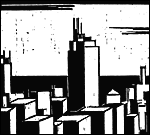Joan Didion, Slouching Towards Bethlehem (Farrar, Straus & Giroux, 1968) The center will not hold, is the pervading theme throughout the collection of essays that make up Slouching Towards Bethlehem. An ironic and distant voyeur, Didion observed Californian life in 1968 with precision, her unusual perspective making the tome a paradigm of the New Journalism. Hers is not the balmy California of Malibu, but the suffocating heat of the desert, where nature is barren and all life is contrived. In one essay, Some Dreamers of the Golden Dream, this becomes explicit: "The Mormons settled this ominous country, and then abandoned it, but by the time they left, the first orange tree had been planted and for the next hundred years the San Bernadino Valley would draw a kind of people who imagined they might live among the talismanic fruit and prosper in the dry air." There is no relief from this sense of foreboding in the tales that Didion has to tell. In the title essay, which borrows from the last line of Yeats' poem The Second Coming, Didion analyzes the hippy community of Haight-Ashbury. It ends with two disquieting vignettes: a mother feeding LSD to her 5-year-old daughter, and a 3-year-old child who gnaws at an electric cable while his parents try to gather up spilled drugs. In the New York Times Book Review in 1977, Joyce Carol Oates wrote: "The drifting, inarticulate children of the 1960s, drug-besotted and prematurely aged, take on for Joan Didion an almost allegorical significance. They are the pitiful casualties of an immense and perhaps inexplicable social change _ an 'atomization' prophesied by Yeats in The Second Coming." (Joyce Carol Oates, A Taut Novel of Disorder in The New York Times Book Review, April 3, 1977, pp1. 34-5. As a piece of journalism, Didion writes with the personal, analytical and cynical view that symbolized the New Journalism. Context is important: she was writing about society falling apart in 1968 when the world, or at least America, certainly seemed to be doing just that. Her work is highly metaphorical and self-aware. She has a keen sense of narrative; indeed in her other famous work The White Album, she began with the line: "We tell ourselves stories to live. . . We live entirely, especially if we are writers, by the imposition of a narrative line upon disparate images, by the 'ideas' with which we have learned to freeze the shifting phantasmagoria which is our cultural experience." Her work shows heavy reporting and is loaded with detail. The Haight-Ashbury story came out of long periods of staying in the community, or rather on its sidelines, observing and noting (see the 1968 New York Times Book Review comment by Dan Wakefield). Many people were writing about the hippy communes, including Tom Wolfe, but Didion was one of the few who "got it." She was a lone reporter, away from the pack, and distant from the pack mentality. Despite the essays appearing in Vogue and The Saturday Evening Post, Didion did not consider herself a journalist _ perhaps her ultimate irony considering we have much to learn from Slouching Towards Bethlehem. Other Reviews: Melvin Maddocks: "Joan Didion is one of those brilliant new-breed journalists who wander sadly and watchfully across the United States as if touring a disaster area. The subjects are conventional, given Miss Didion's temperament: Las Vegas weddings (an essay on American vulgarity); San Francisco hippies (the American dream gone to pot); backstage Hollywood la Lillian Ross; Joan Baez ("a girl who might have interested Henry James"); Howard Hughes (subversive hero of the middle class underground). A substantial element of spiritual biography is present in these pieces of wary skepticism. Though she has a journalist's weakness for converting her themes into 'myths,' 'dreams,' and 'folk' symbols _ she is an original observer and even better, an original thinker. Has anyone written a better treatment of that overexposed topic of the year _ hippies?" (Melvin Maddocks in the Christian Science Monitor, May 16, 1968, p11. |
 |
|||||||||||||||||||||||||||